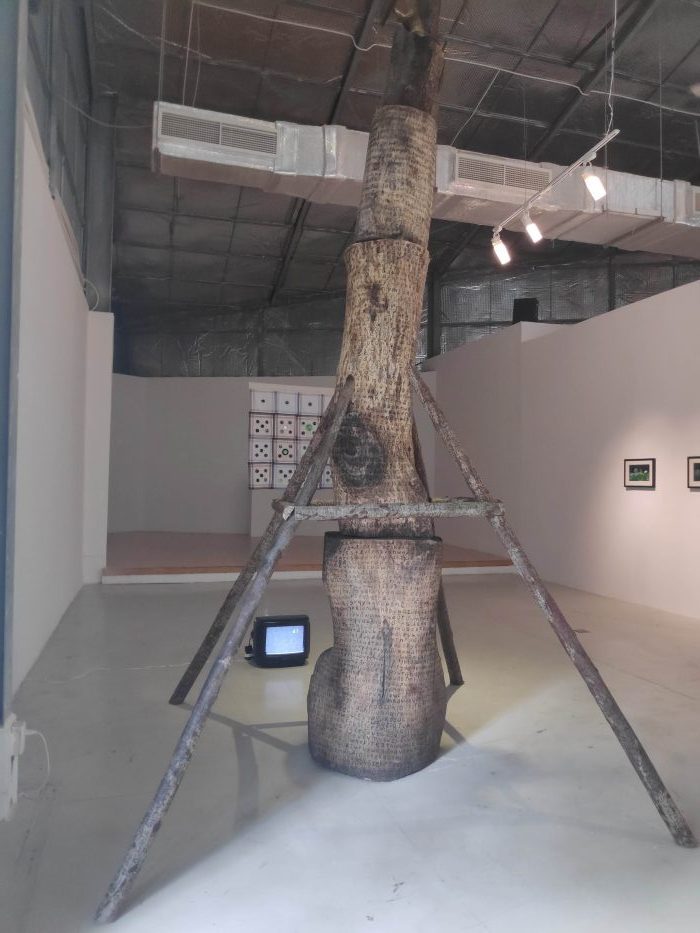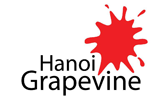Re-examining the Journey of “Singing to the Choir?”: The Space of Our Shared Memories
Words and images by Hà Bi for Hanoi Grapevine and VCCA
Please credit Hanoi Grapevine when you share the article
Do not copy without permission
The article used materials from The Factory
A notebook on the wooden table filled with “marks” of former students, old-fashioned photographs from the many Bup Sen Hong music and dance festivals, and the Buddhist verses for warding off evil and misfortune, are all more or less familiar to each and every of us. These images as featured in the exhibition “Singing to the choir?” present the different perspectives of three artists, Phan Anh, Tran Minh Duc, and Ngoc Nau, each of whom has developed their own understanding on how humanity has attempted to attribute purposes to the metaphysical world, for instance, in its search for the meaning of life.
Opium of the people
The title of the exhibition, “Xuong ca cho ai?” (lit. Ode to whom?), derives from an idiom referring to one who tries to instill beliefs into others with carols. Even when the audience seems to accept the message (judging by the way they resonate), the performer keeps on singing as if not paying attention to their reactions.
Does this mean he does not have faith in his audience? Does the practice of faith validate one’s comprehension of its principles? Must faith be practiced by a collective/in a group context?
Utilizing a wide variety of methods and materials, Phan Anh, Tran Minh Duc and Ngoc Nau have reflected upon faith and religion, which were built upon the stress and distrust of the oppressed class, the so-called “opium of the people” as Karl Marx once put it. These artists set aside social norms in their study of nature, culture and spirituality, believing that these subjects need to be re-interpreted in the language of the 21st century.
Weight
‘Placebo’, a series of mixed-media installations by Phan Anh, measures the weight of faith in human life. The perceived absence of faith often stems from doubt: Why do we have to go through this predicament? Why are others so lucky? It would be easier if we accepted answers given by the majority, but sometimes we simply cannot. Faced with unanswered questions, we tend to give ourselves a general explanation: Some “supreme” power has done this.


Placebo – Nature in Phan Anh’s imagination
Thus, within Phan Anh’s work, a tree seems to have been robbed of its life source, its body carved with characters representing Nature. A convoluted scripture lies at the center, surrounded by people performing rituals or reciting sutras (which they themselves might not understand). The work is marked by a sense of skepticism and irrationality. Nonetheless, this sense roots from sincerity. The motivation behind Phan Anh’s inquiry process stems from his desire to understand the relationship between Nature and humanity’s endeavor to control Nature.



“The scripture” and the obedient devotees
Amputation
Tran Minh Duc’s body of works ‘Nhung canh tay’ (lit. ‘Arms’) are made from different materials (plastic, copper, wood) in different shapes that resembles body parts.



‘Arms’ by Tran Minh Duc
In the past, human limbs were severed during sacrificial rituals or criminal punishment. This practice was at times necessary – such as in medicine. At other, it was how the strong oppressed the weak. In a broader sense, amputation was not just the removal of a limb from the body, but also the removal or elimination of a group of people or culture from the system. For example, many customs of ethnic minorities in Vietnam have disappeared during the expansion of the Viet (aka. Kinh) culture …
Therefore, the broken arm means more than just a discarded object. It also poses a question. The three arms appear to have held onto something which was ultimately stolen, but what and why is it missing? Being so far away from the original body, do the arms still remember their origin? Questions arise one after another, creating new layers of meaning. This can be seen as a way of stimulating “growth” for other parts. Cutting away a part can mark the beginning of another.
In other series such as ‘Em vui hoc lam sao’ (‘How I learn’), ‘Đoàn Thanh Niên’ (‘Youth Union’), ‘Hát trong ánh hồng’ (‘Singing under the pink light’), viewers may find parts of themselves in the past – especially those born in the late 80s and early 90s. A table covered with marks left by the students, old notes that were once their ‘enemies’ or ‘good memories’, dance festivals… all bring back unforgettable moments.


‘Youth Union’ by Tran Minh Duc


‘How I learn’ (Tran Minh Duc) revokes memories of old times
Transition
Over the centuries, we have had cultural transitions from one generation to another. However, only customs that are strong enough, or those chosen by the strong, can survive for long.
Drawing on Dao Mau (worship of the mother goddesses) and the stories about the Ngoc Nau’s homeland in Thai Nguyen, the artist’s works confront the human desire- the greed that lets us be blinded by the glitters of modernization. It subsequently affects our religious practice and our respect for cultural memories, especially in the context of the modern digital life.


‘Offering set number 1’ and the 1-channel video by Ngoc Nau
‘Nhom vat te le 1’ (‘Offering set number 1’) and ‘Loi van chu tru ta giai han’ (‘Verses for warding off evil and misfortune’) incorporate everyday objects used in the amnesty ritual with new technology (LED, coding …) to make futuristic shrines. As they surround the art pieces, viewers inadvertently become the ‘sheep’ obediently listening to the teachings. In another corner, we see majestic sceneries, flashy portraits of some idols, and people mourning the deceased… We continue to consume what this digitally spiritual space produces, without realizing its distortion of moral values.
In this corner of society filled with temptations and oppression, these lyrics contain hidden memories waiting to be discovered. It is ultimately the conscience that will motivate how one takes on this transition and in turn continue to shape the future.



‘Scenic notes’ series by Ngoc Nau
‘Xuong ca cho ai?’ is laden with wonders, doubts, and questions. Everything revolves around how one may be blinded by faith, especially when the weight of his doubts overwhelms his means of acquiring knowledge, when his limbs are severed, or when he can only depend on technology to live on. This exhibition by Phan Anh, Tran Minh Duc, and Ngoc Nau has take place at The Factory center for contemporary arts (Ho Chi Minh City) on January 19, 2020.
















